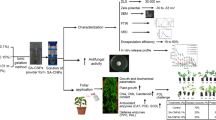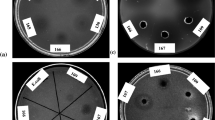Abstract
Pseudomonas syringae pv. tomato DC3000 (Pto DC3000) causes bacterial speck of tomato, a widely spread disease that causes significant economical losses worldwide. It is representative of many bacterial plant diseases for which effective controls are still needed. Despite the antimicrobial properties of chitosan has been previously described in phytopathogenic fungi, its action on bacteria is still poorly explored. In this work, we report that the chitosan isolated from shrimp exoskeletons (70 kDa and 78 % deacetylation degree) exerts cell damage on Pto DC3000. Chitosan inhibited Pto DC3000 bacterial growth depending on its concentration, medium-pH, and presence of metal ion (Mg+2). Biochemical and cellular changes resulting in cell aggregation and impaired bacterial growth were also viewed. In vivo studies using fluorescent probes showed cell aggregation, increase in membrane permeability, and cell death, suggesting the chitosan antibacterial activity is due to its interaction as a polycation with Pto DC3000 membranes. Transmission electron microscopic analysis revealed that chitosan also caused morphological changes and damage in bacterial surfaces. Also, the disease incidence in tomato inoculated with Pto DC3000 was significantly reduced in chitosan pretreated seedlings, revealing a promising action of chitosan as nontoxic biopesticide in tomato plants. Indeed, a wider comprehensive knowledge of the mechanism of action of chitosan in phytopathogenic bacterial cells will increase the chances of its successful application to the control of spread disease in plants.







Similar content being viewed by others
References
Amborabé B-E, Bonmort J, Fleurat-Lessard P, Roblin G (2008) Early events induced by chitosan on plant cells. J Exp Bot 59:2317–2324. doi:10.1093/jxb/ern096
Aranaz I, Mengibar M, Harris R, Panos I, Miralles B, Acosta N, Galed G, Heras A (2009) Functional characterization of chitin and chitosan. Curr Chem Biol 3:203–230. doi:10.2174/187231309788166415
Badawy MEI, Rabea EI (2011) A biopolymer chitosan and its derivatives as promising antimicrobial agents against plant pathogens and their applications in crop protection. Int J Carbohydr Chem. doi:10.1155/2011/460381
Cecchini NM, Monteoliva MI, Alvarez ME (2011) Proline dehydrogenase contributes to pathogen defense in Arabidopsis. Plant Physiol 155:1947–1959. doi:10.1104/pp. 110.167163
Chirkov SN (2002) The antiviral activity of chitosan (review). Appl Biochem Microbiol 38:5–13. doi:10.3390/md10122795
Chung Y-C, Chen C-Y (2008) Antibacterial characteristics and activity of acid-soluble chitosan. Bioresour Technol 99:2806–2814. doi:10.1016/j.biortech.2007.06.044
Chung YC, Wang HL, Chen YM, Li SL (2003) Effect of abiotic factors on the antibacterial activity of chitosan against waterborne pathogens. Bioresour Technol 88:179–184. doi:10.1016/S0960-8524(03)00002-6
Didenko LV, Gerasimenko DV, Konstantinova ND, Silkina TA, Avdienko ID, Bannikova GE, Varlamov VP (2005) Ultrastructural study of chitosan effects on Klebsiella and Staphylococci. Bull Exp Biol Med 140:356–360. doi:10.1007/s10517-005-0489-6
El Hadrami A, Adam LR, El Hadrami I, Daayf F (2010) Chitosan in plant protection. Mar Drugs 8:968–987. doi:10.3390/md8040968
Ferrante P, Scortichini M (2010) Molecular and phenotypic features of Pseudomonas syringae pv. actinidiae isolated during recent epidemics of bacterial canker on yellow kiwifruit (Actinidia chinensis) in central Italy. Plant Pathol 59:954–962. doi:10.1111/j.1365-3059.2010.02304.x
Gilbert P, Maira-Litran T, McBain AJ, Rickard AH, Whyte FW (2002) The physiology and collective recalcitrance of microbial biofilm communities. Adv Microb Physiol 46:202–256. doi:10.1016/S0065-2911(02)46005-5
Glick BR, Bashan Y (1997) Genetic manipulation of plant growth-promoting bacteria to enhance biocontrol of phytopathogens. Biotechnol Adv 15:353–378. doi:10.1016/S0734-9750(97)00004-9
Goy RC, Britto D, Assis OBG (2009) A review of the antimicrobial activity of chitosan. Polímeros 19:241–247. doi:10.1590/S0104-14282009000300013
Helander IM, Nurmiaho-Lassila EL, Ahvenainen R, Rhoades J, Roller S (2001) Chitosan disrupts the barrier properties of the outer membrane of Gram-negative bacteria. Int J Food Microbiol 71:235–244. doi:10.1016/S0168-1605(01)00609-2
Ji P, Campbell HL, Kloepper JW, Jones JB, Suslow TV, Wilson M (2006) Integrated biological control of bacterial speck and spot of tomato under field conditions using foliar biological control agents and plant growth-promoting rhizobacteria. Biol Control 36:358–367. doi:10.1016/j.biocontrol.2005.09.003
Kim S-K, Rajapakse N (2005) Enzymatic production and biological activities of chitosan oligosaccharides (COS): a review. Carbohydr Polym 62:357–368. doi:10.1016/j.carbpol.2005.08.012
King EO, Ward MK, Raney DE (1954) Two simple media for the demonstration of pyocyanin and fluorescin. J Lab Clin Med 44:301–307
Kong M, Chen XG, **ng K, Park HJ (2010) Antimicrobial properties of chitosan and mode of action: a state of the art review. Int J Food Microbiol 144:51–63. doi:10.1016/j.ijfoodmicro.2010.09.012
Kulikov SN, Chirkov SN, Il´ina AV, Lopatin SA, Varlamov VP (2006) Effect of the molecular weight of chitosan on its antiviral activity in plants. Appl Biochem Microbiol 42:200–203. doi:10.1134/s0003683806020165
Kumirska J, Weinhold MX, Thöming J, Stepnowski P (2011) Biomedical activity of chitin/chitosan based materials—influence of physicochemical properties apart from molecular weight and degree of N-acetylation. Polymers 3:1875–1901. doi:10.3390/polym3041875y
Lewis K (2001) Riddle of biofilm resistence. Antimicrob Agents Chemother 45:999–1007. doi:10.1128/AAC.45.4.999-1007.2001
Li B, Wang X, Chen R, Huangfu W, **e G (2008) Antibacterial activity of chitosan solution against Xanthomonas pathogenic bacteria isolated from Euphorbia pulcherrima. Carbohydr Polym 72:287–292. doi:10.1016/j.carbpol.2007.08.012
Li B, Liu BP, Su T, Wang F, Tang QM, Fang Y, **e GL, Sun GC (2010) Effect of chitosan solution on the inhibition of Pseudomonas fluorescens causing bacterial head rot of broccoli. Plant Pathol J 26:189–193
Li B, Liu BP, Shan CL, Ibrahim M, Lou YH, Wang YL, **e GL, Li HY, Sun GC (2013) Antibacterial activity of two chitosan solutions and their effect on rice bacterial leaf blight and leaf streak. Pest Manag Sci 69:312–320. doi:10.1002/ps.3399
Liu N, Chen X-G, Park H-J, Liu C-G, Liu C-S, Meng X-H, Yu L-J (2006) Effect of MW and concentration of chitosan on antibacterial activity of Escherichia coli. Carbohydr Polym 64:60–65. doi:10.1016/j.carbpol.2005.10.028
Lou MM, Zhu B, Muhammad I, Li B, **e GL, Wang YL, Li HY, Sun GC (2011) Antibacterial activity and mechanism of action of chitosan solutions against apricot fruit rot pathogen Burkholderia seminalis. Carbohydr Res 346:1294–1301. doi:10.1016/j.carres.2011.04.042
Murashige T, Skoog F (1962) A revised medium for rapid growth and bio assays with tobacco tissue cultures. Physiol Plant 15:473–497. doi:10.1111/j.1399-3054.1962.tb08052.x
Nemchinov LG, Shabala L, Shabala S (2007) Calcium efflux as a component of the hypersensitive response of Nicotiana benthamiana to Pseudomonas syringae. Plant Cell Physiol 49:40–46. doi:10.1093/pcp/pcm163
Novo DJ, Perlmutter NG, Hunt RH, Shapiro HM (2000) Multiparameter flow cytometric analysis of antibiotic effects on membrane potential, membrane permeability, and bacterial counts of Staphylococcus aureus and Micrococcus luteus. Antimicrob Agents Chemother 44:827–834. doi:10.1128/AAC.44.4.827-834.2000
Palma-Guerrero J, Jansson HB, Salinas J, Lopez-Llorca LV (2008) Effect of chitosan on hyphal growth and spore germination of plant pathogenic and biocontrol fungi. J Appl Microbiol 104:541–553. doi:10.1111/j.1365-2672.2007.03567.x
Palma-Guerrero J, Huang IC, Jansson HB, Salinas J, Lopez-Llorca LV, Read ND (2009) Chitosan permeabilizes the plasma membrane and kills cells of Neurospora crassa in an energy dependent manner. Fungal Genet Biol 46:585–594. doi:10.1016/j.fgb.2009.02.010
Palma-Guerrero J, Lopez-Jimenez JA, Perez-Berna AJ, Huang IC, Jansson HB, Salinas J, Villalain J, Read ND, Lopez-Llorca LV (2010) Membrane fluidity determines sensitivity of filamentous fungi to chitosan. Mol Microbiol 75:1021–1032. doi:10.1111/j.1365-2958.2010.07039.x
Raafat D, von Bargen K, Haas A, Sahl H-G (2008) Insights into the mode of action of chitosan as an antibacterial compound. Appl Environ Microbiol 74:3764–3773. doi:10.1128/AEM.00453-08
Rabea EI, Badawy MET, Stevens CV, Smagghe G, Steurbaut W (2003) Chitosan as antimicrobial agent: applications and mode of action. Biomacromolecules 4:1457–1465. doi:10.1021/bm034130m
Rodríguez MS, Albertengo LE (2005) Interaction between chitosan and oil under stomach and duodenal digestive chemical conditions. Biosci Biotechnol Biochem 69:2057–2062. doi:10.1271/bbb.69.2057
Rodríguez M, Montero M, Dello Staffolo M, Martino M, Bevilacqua A, Albertengo L (2008) Chitosan influence on glucose and calcium availability from yogurt: in vitro comparative study with plants fibre. Carbohydr Polym 74:797–801. doi:10.1016/j.carbpol.2008.04.046
Roth BL, Poot M, Yue ST, Millard PJ (1997) Bacterial viability and antibiotic susceptibility testing with SYTOX green nucleic acid stain. Appl Environ Microbiol 63:2421–2431
Tang H, Zhang P, Kieft TL, Ryan SJ, Baker SM, Wiesmann WP, Rogelj S (2010) Antibacterial action of a novel functionalized chitosan-arginine against Gram-negative bacteria. Acta Biomater 6:2562–2571. doi:10.1016/j.actbio.2010.01.002
Tao Y, Qian L-H, **e J (2011) Effect of chitosan on membrane permeability and cell morphology of Pseudomonas aeruginosa and Staphyloccocus aureus. Carbohydr Polym 86:969–974. doi:10.1016/j.carbpol.2011.05.054
Tsai G-J, Su W-H (1999) Antibacterial activity of shrimp chitosan against Escherichia coli. J Food Prot 62:239–243
Uppalapati SR, Ishiga Y, Wangdi T, Urbanczyk-Wochniak E, Ishiga T, Mysore KS, Bender CL (2008) Pathogenicity of Pseudomonas syringae pv. tomato on tomato seedlings: phenotypic and gene expression analyses of the virulence function of coronatine. Mol Plant Microbe Interact 21:383–395. doi:10.1094/MPMI-21-4-0383
Wang X, Du Y, Fan L, Liu H, Hu Y (2005) Chitosan–metal complexes as antimicrobial agent: synthesis, characterization and structure-activity study. Polym Bull 55:105–113. doi:10.1007/s00289-005-0414-1
Wang Y, Li L, Li B, Wu G, Tang Q, Ibrahim M, Li H, **e G, Sun G (2012) Action of chitosan against Xanthomonas pathogenic bacteria isolated from Euphorbia pulcherrima. Molecules 17:7028–7041. doi:10.3390/molecules17067028
Wilson M, Campbell HL, Ji P, Jones JB, Cuppels DA (2002) Biological control of bacterial speck of tomato under field conditions at several locations in North America. Phytopathology 92:1284–1292. doi:10.1094/phyto.2002.92.12.1284
Zúñiga A, Debbaudt A, Albertengo L, Rodríguez MS (2010) Synthesis and characterization of N-propyl-N-methylene phosphonic chitosan derivative. Carbohydr Polym 79:475–480. doi:10.1016/j.carbpol.2009.08.011
Acknowledgments
This work was supported by grants from Agencia Nacional de Promoción Científica y Tecnológica (ANPCyT PICT 0716), Consejo Nacional de Investigaciones Científicas y Técnicas (CONICET), and Universidad Nacional de Mar del Plata (UNMdP) to CAC. CAC is member of the research staff of CONICET. AYM is a postdoctoral fellow of the same institution. The authors acknowledge Dra. Maria Elena Alvarez (UNC) for kindly providing the strain of Pseudomonas syringae pv. tomato DC3000 and Lic. Leonardo Di Meglio (UNMdP) and Dra. Julieta Mendieta (UNMdP) for their helpful with microscopy analysis. We also thank Dr Rubén Conde for his critical reading of the manuscript.
Author information
Authors and Affiliations
Corresponding author
Electronic supplementary material
Below is the link to the electronic supplementary material.
ESM 1
(PDF 183 kb)
Rights and permissions
About this article
Cite this article
Mansilla, A.Y., Albertengo, L., Rodríguez, M.S. et al. Evidence on antimicrobial properties and mode of action of a chitosan obtained from crustacean exoskeletons on Pseudomonas syringae pv. tomato DC3000. Appl Microbiol Biotechnol 97, 6957–6966 (2013). https://doi.org/10.1007/s00253-013-4993-8
Received:
Revised:
Accepted:
Published:
Issue Date:
DOI: https://doi.org/10.1007/s00253-013-4993-8




